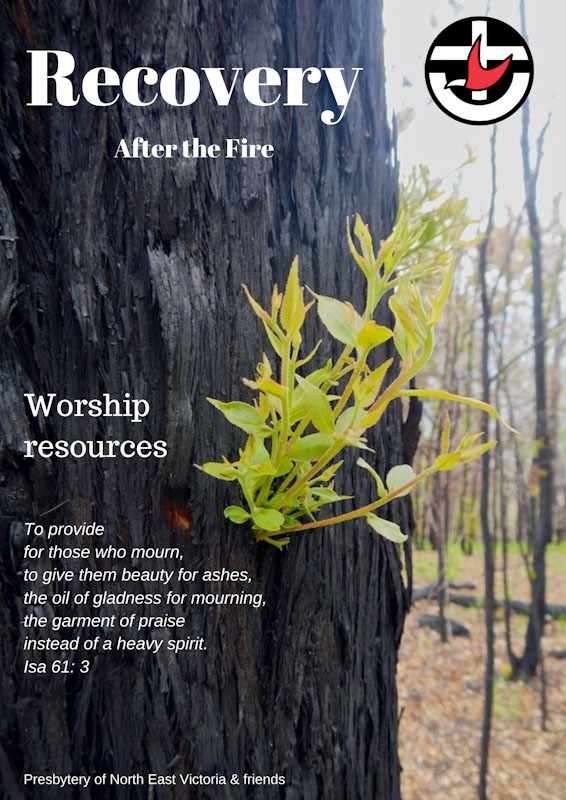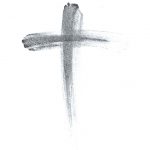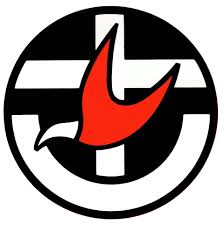
Recovery
Our churches have deep roots in rural towns and villages. We have been there for many years. God willing we will be there for many years to come. We are not psychologists, but at the core of our faith is the belief of “Immanuel” the God who is with us. John at the beginning of his Gospel says, “And the Word became flesh and lived among us.” (Jn 1:14) The timeless Word became incarnate. Incarnate means “to put skin on.’ God’s response to human need, hope, sorrow, desire, pain, joy, and suffering is to wrap the divine up in flesh, and be present. On a given day, in a given situation, that incarnated God might be you. It might be me. This is how the divine chooses to be in the world.
Week by week our services of worship proclaim that there is healing for the broken, there is hope for the despairing, that there is forgiveness and grace for things done and undone, that the final word is not death, but love. Love that creates new life.
The UCA Presbytery of North East Victoria (and friends) have decided to produce a series of worships resources to support our congregations to proclaim such messages to those who have experienced such deep loss. These resources will be linked to the church year and to lectionary readings and made freely available for use by ministry agents, lay preachers and congregations.
Starting with Ash Wednesday and Lent, we will provide liturgies, hymn suggestions, prayers and meditations. There will variations from formal liturgy, including resources and ideas for Messy Church and contemporary worship.
If you would like to contribute to these resources in any way, please contact us.
Brian Spencer
Education, Resources and Innovation Support Minister
Presbytery of North East Victoria
brianspencer@northeastvicuca.net.au
Ph 0400 274482
Recovery - After the Fire
Mid-afternoon on Boxing Day 2013 a neighbour drove into my yard to warn me that a wildfire was headed my way- fast! A stubble fire, caused by a neighbour harvesting wheat some six kilometres away, was now cresting the small range of hills behind my property.
Grass fires move fast. Within 15 minutes the fire had swept through the stubble and into my property. I successfully defended the house and sheds, but once it was in the vineyard it was another story. Ten acres of vines, irrigation system and posts damaged or destroyed and my life changed.
Fire moves fast, and leaves in its wake a trail of devastation.
Fire damages more than it burns (and it has burnt so much).
It damages homes and property. It damages livestock and crops.
It damages the land. It damages the forests and the wildlife.
It damages businesses and communities.
It damages families and relationships.
It damages hopes and dreams.
It damages the soul.
The media loves the action photo and the stories of heroism and tragedy but the circus quickly moves on.
Recovery is slow.
It’s not an event, it’s a process.
We need to work through our grief, our loss, our despair, our anger. We need to overcome our impatience to proclaim. “I’m over it. I have recovered.”
People talk of “the road to recovery”. The truth is there are many different roads that lead to recovery, but the road has many turnings, is ill-defined and the signposts are not clear.
We tend to treat recovery in the same way as the fire. We rush to pour resources into extinguishing the flames. Yes we need quick, short-term responses to immediate need. But we also need long-term, continual support and reinforcement for the hidden damage to our soul, our psyche, our innermost self.
There are waves of grief, loss, despair, fear, dread, weariness and fatigue.
There is compassion, hope, love, grace, relief, courage, healing and new life.
There is blame, guilt, brokenness and regret. So much “What if?”; “Should I have?” and “If only.”
There is unexpected joy and moments of great beauty.
We don’t return to what was before. We are changed. We walk with a limp.
If we are lucky we are transformed. We take the worst that life has thrown at us, and become stronger, more resilient, our priorities sharpened, and our faith deepened.
Ash Wednesday Service
 Lent is a season of forty days, not counting Sundays, which begins on Ash Wednesday and ends on Holy Saturday. The season is a preparation for celebrating Easter.
Lent is a season of forty days, not counting Sundays, which begins on Ash Wednesday and ends on Holy Saturday. The season is a preparation for celebrating Easter.
Celebrating Ash Wednesday is an ancient tradition, which centres on our mortality and on the confession of sin before God. This dual focus is maintained in the light of God’s redeeming love in Jesus Christ. While we are called to acknowledge our sinfulness in this service, it also calls us to set our direction towards the cross and beyond. This is the nature of repentance. To turn from our sinful way and to turn to Christ.
Click Here to Download the Order of Service in MS Word
Click Here to Download the Order of Service in MS PowerPoint Slides

Lenten Candle Liturgy
The Lenten Candle Liturgy is very similar to the Advent wreath. You put the candles on your table, but instead of lighting one each week, you extinguish one each week each Sunday during Lent until it’s Easter time. While an Advent wreath is shaped in a circle, the candles at Lent are traditionally in the shape of a cross. This candle liturgy is a little different. Responding to the bushfires of the 2019-2020 summer in Australia, we suggest using a burnt log for your candle holder and the weekly meditations reflect on the set Lectionary readings with the context of recovery from the ordeal of the bushfires. Be sensitive to your people and their needs. Candles represent light, the light of Christ, but they are also fire, and this may raise concerns for some people.
